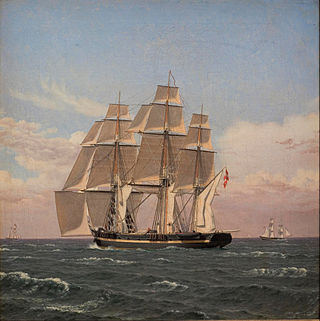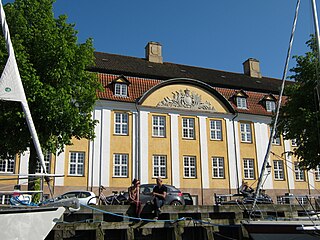
Absalon was a Danish statesman and prelate of the Catholic Church who served as the bishop of Roskilde from 1158 to 1192 and archbishop of Lund from 1178 until his death. He was the foremost politician and church father of Denmark in the second half of the 12th century, and was the closest advisor of King Valdemar I of Denmark. He was a key figure in the Danish policies of territorial expansion in the Baltic Sea, Europeanization in close relationship with the Holy See, and reform in the relation between the Church and the public. He combined the ideals of Gregorian Reform with loyal support of a strong monarchical power.

The Fridtjof Nansen-class frigates are a class of frigates that are the main surface combatant units of the Royal Norwegian Navy. The ships are named after famous Norwegian explorers, with the lead ship of the class bearing the name of Fridtjof Nansen. Five ships were ordered from Spanish shipbuilder Bazan.
Absalom (Avshalom) is a son of King David in the Old Testament.

Several ships of the Royal Danish-Norwegian Navy (1509–1814) and the Royal Danish Navy have borne the name Najaden, after the mythological water spirit, including:

The Frogman Corps is the maritime special operations force of the Danish Armed Forces part of Special Operations Command. On 1 July 2015, the Frogman Corps transferred from the Royal Danish Navy to the newly established Special Operations Command.

HDMS Absalon (F341) and her sister ship Esbern Snare are the two members of the Absalon class. The lead ship of the class is named after Danish archbishop and statesman Absalon and received full operational status in 2007.

HDMS Esbern Snare (F342) is an Absalon-class frigate and is, along with her sister ship, the HDMS Absalon, amongst the largest combat vessels currently commissioned in the Royal Danish Navy.
L17 or L-17 may refer to:

The Absalon class are frigates of the Royal Danish Navy, commissioned in 2005. The two ships in the class may be described as a hybrid between a frigate and military transport ship with multiple role capabilities, with the capacity to be transformed from a combat ship with the firepower of a traditional frigate to a hospital ship within a day.
Absalon (c. 1128–1201) was a Danish archbishop and statesman.
L16 or L-16 may refer to:

MV Taiko was a roll-on/roll-off (RoRo) freighter managed by the Norwegian-Swedish shipping line Wallenius Wilhelmsen Logistics. She was built as Barber Hector by Hyundai Heavy Industries at Ulsan, South Korea in 1984 for Blue Funnel Line, part of the Liverpool company Ocean Transport & Trading Ltd, and was Blue Funnel's last newbuilding. She was deployed on Barber Blue Sea Line, a joint venture between Blue Funnel, Wilh. Wilhelmsen, Oslo and the Broström Group of Sweden. In 1988 Ocean withdrew from Barber Blue Sea line and Barber Hector was sold to the Swedish partner, chartered to Wilhelmsen and renamed Taiko. Wilhelmsen purchased the vessel in 1993.
Five ships of the Danish Royal Navy have borne the name HDMS Springeren:
At least two ships of the Royal Danish Navy have borne the name HDMS Absalon:

The MV Beluga Nomination incident was the capture and attempted liberation of a German freighter from Somali pirates by the Seychelles Coast Guard and Royal Danish Navy in January 2011. A few days after the taking of MV Beluga Nomination, a Seychelles patrol boat and a Danish flexible support ship, HDMS Esbern Snare, encountered the pirates and engaged in a failed rescue operation.

The Royal Danish Naval Museum is a museum dedicated to the history of the Royal Danish Navy. The displays include a collection of naval models which dates back to late 17th century. The museum is based in Søkvæsthuset, a former naval hospice which overlooks Christianshavn Canal.
Four ships of the Danish Royal Navy have borne the name HDMS Niels Juel:

HDMS Hauch was a Danish gunboat, launched in 1862 and under command the following year. It was named after the naval officer Jens Erik Hauch, who died during the Battle of Copenhagen, while bravely defending the decommissioned frigate Kronborg against three Royal Navy ships of the line. Hauch can be viewed as a scaled-down version of the preceding six gunboats of the Thura class. Hauch was built entirely in iron and the smaller size meant that it could only accommodate a single cannon. The 30 lb smoothbore cannon was not very accurate and was replaced by a smaller, but rifled 18 lb cannon in 1864. Towards the end of her career the armament consisted of two small smoothbore cannons (falconets), used for warning shots during fisheries inspection duties. The steam engine was reused from the scrapped gunboat Støren. This engine lasted until 1886, when it was replaced by a new Burmeister & Wain 200 HP steam engine.

Esbern Snare, also known as Esbern the Resolute, (1127–1204) was a høvding, or chieftain, royal chancellor and crusader. His family were members of the powerful Hvide clan. In 1192, during the Crusades and after the fall of Jerusalem, he led a small group of Danish soldiers to the Holy Land. Upon his return, he had the Church of Our Lady, Kalundborg built.

HDMS Peter Tordenskiold (F356) was a Niels Juel-class corvette in the Royal Danish Navy which was in use until 1990. The ship is named after Peter Tordenskjold, a 17th-century Dano-Norwegian vice admiral.
This page is based on this
Wikipedia article Text is available under the
CC BY-SA 4.0 license; additional terms may apply.
Images, videos and audio are available under their respective licenses.










